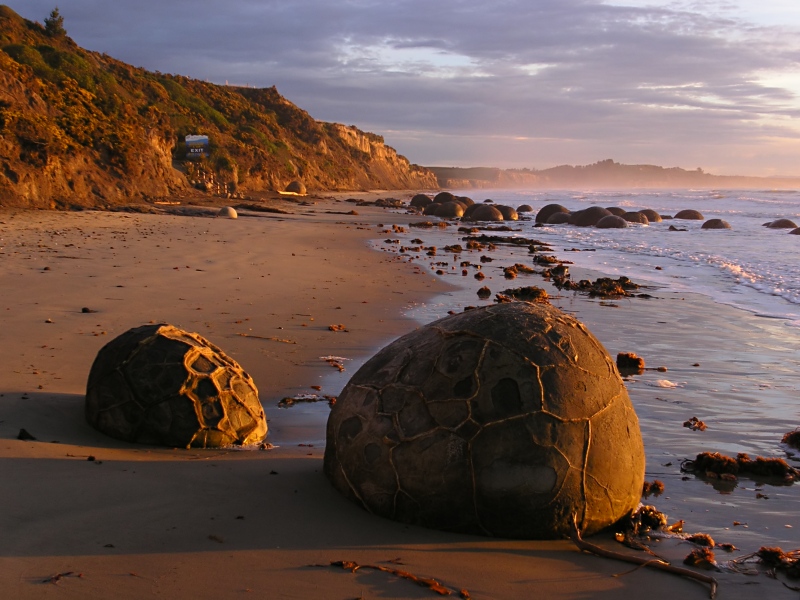The Mysterious Moeraki Boulders – New Zealand’s Dragon Eggs

The Moeraki Boulders are huge spherical boulders that look like the eggs of some gigantic dragon that we see in fantasy movies.
These amazing rocks lay along a stretch of Koekohe Beach on the Otago coast in New Zealand, appearing individually or as clusters. The area where they occur is a protected scientific reserve.
Constant wave action and coastal erosion leads to the creation of these mudstone giants.
According to Maori legend, the boulders are remains of eel baskets, calabashes, and kumara (sweet potato) that were washed on the coast when the Āraiteuru wrecked.
Āraiteuru was a traditional Maori canoe that brought the ancestors of Ngai Tahu people to the South Island of New Zealand. T
he legend says that the things that were in the canoe are today’s Moeraki Boulders and that the rocks extending towards the sea from Shag Point are the leftovers of the canoe.
Also, the rocky promontory nearby is believed to be the body of the captain of the Āraiteuru.

The Moeraki boulders have inspired many artists through history that ended up painting this natural marvel. In 1848, Mantell sketched the beach and its boulders, more numerous than now.
The picture can be seen today in the Alexander Turnbull Library in Wellington. In the new era, Moeraki Boulders are a great tourist attraction, and people from New Zealand, as well as numerous foreigners, come here to admire these astonishing rocks.
The most interesting aspect of the boulders is their size and their form. All of them are spherical or almost spherical, with a diameter of 6 to 11 feet. What’s even more shocking is that the shape and the size are not unique to Moeraki Boulders.
On the North Island of New Zealand, there are other spherical boulders called Koutu. Koutu Boulders are found on the beaches, inside the cliffs and beneath the surface in the area of Hokianga Harbour.
Like the Moeraki Boulders, the Koutu Boulders also have a diameter of about 10 feet. 12 miles south of Shag Point there is one more group of large stones known as the Katiki Boulders.
The Katiki Boulders are a bit different from Moeraki because apart from the spherical shape they occur as flat round discs as well. Some of these boulders contain bones of the Mesozoic marine reptiles such as mosasaurs and plesiosaurs.

The Moeraki boulders consist of mud, fine silt and clay, cemented by calcite. The level of cementations varies depending on the age of formation.
The inner side of the boulders is relatively weak while the outside rim is quite hard. The boulders have cracks on the top that open towards the lower parts. The shallow inside reveals the brown and the yellow calcite that fills the gaps of the boulder.
Some Moeraki Boulders have a very thin innermost layer of dolomite and quartz covering the yellow calcite spar. This layer is the last one formed.
The larger boulders, 6.6 feet in diameter, are estimated to have taken 4 to 5.5 million years to grow while 33 to 164 feet of marine mud accumulated on the seafloor above them.

If you ever visit the South Island of New Zealand, don’t miss the opportunity to see the Moeraki Boulders, as they are a wonderful gift of nature.
Being near these gigantic rock balls is a unique experience that will remind you of your childhood mystery games. Don’t stare at your screen, go out there and meet our beautiful planet! Good luck!
If you have any comments then please drop us a message on our Outdoor Revival Facebook page
If you have a good story to tell or blog let us know about it on our FB page, we’re also happy for article or review submissions, we’d love to hear from you. We live in a beautiful world, get out there and enjoy it. Outdoor Revival – Reconnecting us all with the Outdoors.
